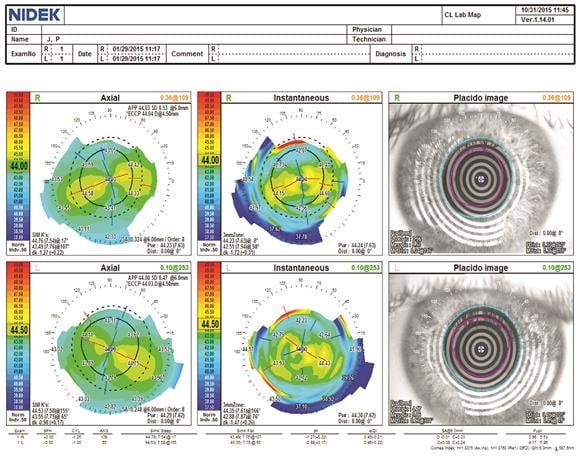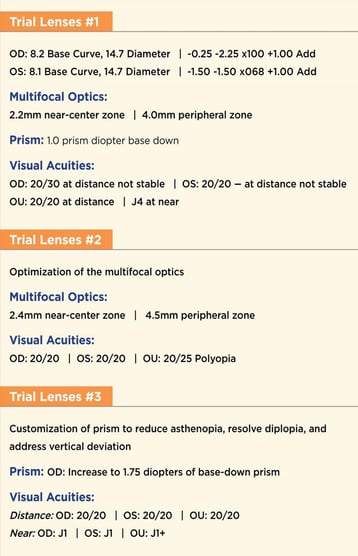Having the ability to specify the amount of vertical prism in a patient’s contact lens is just one of the many benefits to prescribing SpecialEyes contact lenses. Vertical Prism is most often used as a method of stabilization in SpecialEyes custom toric and multifocal toric contact lenses. However, stabilization is not the only indication for adding additional base down prism. This case examines the off-label use of additional prism to reduce asthenopia and diplopia for a patient wearing the SpecialEyes 54 Multifocal Toric. You can read the full case study by clicking here.
Patient Measurements
Simulated Keratometry (K) Readings:
OD: 43.49@107/44.76@017
OS: 43.55@65/44.53@155
Manifest Refraction:
OD: -0.25 -2.25 x100 +1.00 add
OS: -1.50 -1.50 x068 +1.00 add
DVA: 20/20 | NVA: 20/20
Pupil Size Measurements (Nidek OPD Scan III):
OD: 4.24mm photopic | 5.65mm mesopic
OS: 4.11mm photopic | 5.86mm mesopic
*An effective pupil size of 4.9mm was calculated as the patient’s pupil size in regular room illumination by taking the difference of the photopic and mesopic pupil size measurements. This value was utilized in designing the multifocal optics.

The subject of this case report is a 41-year-old Caucasian male who was fitted in simultaneous-design center near custom soft toric multifocal contact lenses in both eyes. Using the SpecialEyes Arc Length Calculator, a set of trial lenses were designed based on the above keratometric readings and manifest refraction. The custom near center and peripheral multifocal optic zone sizes were initially chosen based on the practitioner’s prior experience with this lens design.
During the initial trial contact lens dispense and follow up, (Table 1) the patient expressed a chief complaint of blurred vision at near and intermediate viewing distances. Near visual acuity of J4 confirmed this chief complaint. Via slit lamp examination the lens fitting characteristics were optimal, proper lens movement was noted, and lens surface was clean and free of defects.
Pupil size measurements were then referenced and action was taken to redesign the multifocal optics. The patient’s 4.9mm effective pupil size measurement and add power was input into the SpecialEyes Multifocal Simulator to assist in the redesign of the multifocal optics to improve visual performance. The Multifocal Simulator suggested a 2.2mm near center zone size and 4.4mm peripheral zone size. The near center zone size was modified slightly larger to 2.4mm since the prior trial lens near center zone size was 2.2mm and the patient was seeing J4 at near with that lens. Increasing the near center zone size provided more area of near optics over the patient’s pupil diameter area and improved near vision. The peripheral zone size was also modified to 4.5mm which reduced the rate at which the intermediate powers progressed (decreased eccentricity) and resulted in improved intermediate vision.

Table 1
Optimizing the multifocal optics did improve visual performance for the patient (Table 1); however the patient still experienced a disturbance. He complained that his eyes were not working well together and that “things were floating” at distance and near. A vertical deviation was determined using dissociated phorias and this was successfully integrated in the lens design by customizing prism. Base down prism in the right lens was increased from 1.0 diopter to a total of 1.75 diopters to address the vertical deviation. This customization of vertical prism improved binocularity and further improved visual performance (Table 1).
In conclusion, this case demonstrates the success that is possible with a customized multifocal lens design. By optimizing the custom multifocal optics according to the patient’s pupil size, the patient experienced improved near and intermediate vision. In addition, a fully customized soft multifocal contact lens design with customizable base down prism provides encouraging results as an off-label use for patients with vertical deviation. If you have questions about customizable vertical prism in our custom toric and multifocal toric contact lenses, please contact our consultation team.
Thanks for joining us!
